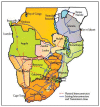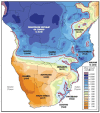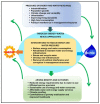Climate Change Adaptation through the Water-Energy-Food Nexus in Southern Africa
- PMID: 30347771
- PMCID: PMC6210720
- DOI: 10.3390/ijerph15102306
Climate Change Adaptation through the Water-Energy-Food Nexus in Southern Africa
Abstract
Climate change is a complex and cross-cutting problem that needs an integrated and transformative systems approach to respond to the challenge. Current sectoral approaches to climate change adaptation initiatives often create imbalances and retard sustainable development. Regional and international literature on climate change adaptation opportunities and challenges applicable to southern Africa from a water-energy-food (WEF) nexus perspective was reviewed. Specifically, this review highlights climate change impacts on water, energy, and food resources in southern Africa, while exploring mitigation and adaptation opportunities. The review further recommends strategies to develop cross-sectoral sustainable measures aimed at building resilient communities. Regional WEF nexus related institutions and legal frameworks were also reviewed to relate the WEF nexus to policy. Southern Africa is witnessing an increased frequency and intensity in climate change-associated extreme weather events, causing water, food, and energy insecurity. A projected reduction of 20% in annual rainfall by 2080 in southern Africa will only increase the regional socio-economic challenges. This is exacerbating regional resource scarcities and vulnerabilities. It will also have direct and indirect impacts on nutrition, human well-being, and health. Reduced agricultural production, lack of access to clean water, sanitation, and clean, sustainable energy are the major areas of concern. The region is already experiencing an upsurge of vector borne diseases (malaria and dengue fever), and water and food-borne diseases (cholera and diarrhoea). What is clear is that climate change impacts are cross-sectoral and multidimensional, and therefore require cross-sectoral mitigation and adaptation approaches. In this regard, a well-coordinated and integrated WEF nexus approach offers opportunities to build resilient systems, harmonise interventions, and mitigate trade-offs and hence improve sustainability. This would be achieved through greater resource mobilisation and coordination, policy convergence across sectors, and targeting nexus points in the landscape. The WEF nexus approach has potential to increase the resilience of marginalised communities in southern Africa by contributing towards attaining the Sustainable Development Goals (SDGs 1, 2, 3, 6, 7, and 13).
Keywords: Southern Africa; adaptation; climate change; resilience; water-energy-food nexus.
Conflict of interest statement
The authors declare no conflict of interest.
Figures








Similar articles
-
Operationalising the water-energy-food nexus through the theory of change.Renew Sustain Energy Rev. 2021 Oct;149:111416. doi: 10.1016/j.rser.2021.111416. Renew Sustain Energy Rev. 2021. PMID: 37693280 Free PMC article.
-
The Water-Energy-Food Nexus as a Tool to Transform Rural Livelihoods and Well-Being in Southern Africa.Int J Environ Res Public Health. 2019 Aug 18;16(16):2970. doi: 10.3390/ijerph16162970. Int J Environ Res Public Health. 2019. PMID: 31426610 Free PMC article.
-
Climate impacts on European agriculture and water management in the context of adaptation and mitigation--the importance of an integrated approach.Sci Total Environ. 2010 Nov 1;408(23):5667-87. doi: 10.1016/j.scitotenv.2009.05.002. Epub 2009 Jun 5. Sci Total Environ. 2010. PMID: 19501386
-
Towards understanding the integrative approach of the water, energy and food nexus.Sci Total Environ. 2017 Jan 1;574:1131-1139. doi: 10.1016/j.scitotenv.2016.09.046. Epub 2016 Oct 14. Sci Total Environ. 2017. PMID: 27710905 Review.
-
Sustainable irrigation technologies: a water-energy-food (WEF) nexus perspective towards achieving more crop per drop per joule per hectare.Environ Res Lett. 2022 Jul 1;17(7):073003. doi: 10.1088/1748-9326/ac7b39. Epub 2022 Jul 6. Environ Res Lett. 2022. PMID: 35812360 Free PMC article. Review.
Cited by
-
Operationalising the water-energy-food nexus through the theory of change.Renew Sustain Energy Rev. 2021 Oct;149:111416. doi: 10.1016/j.rser.2021.111416. Renew Sustain Energy Rev. 2021. PMID: 37693280 Free PMC article.
-
Examining urban resilience through a food-water-energy nexus lens to understand the effects of climate change.iScience. 2024 Jun 19;27(7):110311. doi: 10.1016/j.isci.2024.110311. eCollection 2024 Jul 19. iScience. 2024. PMID: 39092181 Free PMC article.
-
An African perspective on the Water-Energy-Food nexus.Sci Rep. 2023 Oct 6;13(1):16842. doi: 10.1038/s41598-023-43606-9. Sci Rep. 2023. PMID: 37803054 Free PMC article.
-
Embracing complexities in agricultural water management through nexus planning.Irrig Drain. 2024 Nov;73(5):1695-1716. doi: 10.1002/ird.3041. Epub 2024 Sep 29. Irrig Drain. 2024. PMID: 40092646 Free PMC article.
-
An integrative analytical model for the water-energy-food nexus: South Africa case study.Environ Sci Policy. 2020 Jul;109:15-24. doi: 10.1016/j.envsci.2020.04.010. Environ Sci Policy. 2020. PMID: 39035455 Free PMC article.
References
-
- Niang I., Ruppel O.C., Abdrabo M.A., Essel A., Lennard C., Padgham J., Urquhart P. Climate Change 2014: Impacts, Adaptation, and Vulnerability. Part B: Regional Aspects. Contribution of Working Group II to the Fifth Assessment Report of the Intergovernmental Panel on Climate Change. Cambridge University Press; Cambridge, UK: New York, NY, USA: 2014. pp. 199–1265.
-
- Nhamo L., Mabhaudhi T., Modi A.T. Preparedness or repeated short-term relief aid? Building drought resilience through early warning in southern Africa. Water SA. 2018 in publishing.
-
- Schulze R. A 2011 Perspective on Climate Change and the South African Water Sector. Water Research Commission (WRC); Pretoria, South Africa: 2012. [(accessed on 28 August 2018)]. 1843/2/11; Research Report No. TT 518/12. Available online: www.wrc.org.za/Knowledge%20Hub%20Documents/Research%20Reports/TT%20518-1....
-
- Jury M.R. Climate trends in southern Africa. S. Afr. J. Sci. 2013;109:1–11. doi: 10.1590/sajs.2013/980. - DOI
-
- Sun J., Yang K. The wicked problem of climate change: A new approach based on social mess and fragmentation. Sustainability. 2016;8:1312. doi: 10.3390/su8121312. - DOI
Publication types
MeSH terms
LinkOut - more resources
Full Text Sources
Medical

